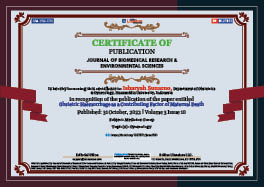Medicine Group . 2022 October 31;3(10):1279-1280. doi: 10.37871/jbres1591.
Obstetric Haemorrhage as a Contributing Factor of Maternal Death
Isharyah Sunarno*
Obstetric hemorrhage is a nightmare for a pregnant woman and her family. It is one of the “trias maternal death”, although it is a factor that can be avoided with proper and timely treatment. Health service providers and stakeholders in both developed and underdeveloped nations are extremely concerned about obstetric hemorrhage. To guarantee that the standardized protocols for obstetric hemorrhage are consistently applied at all facilities throughout Japan, the Societies in Japan, which are made up of the Japan Society of Obstetrics and Gynecology (JSOG) and Japan Association of Obstetricians and Gynecologists (JAOG), have been conducting educational activities for obstetric caregivers from all types of obstetric facilities [1]. Women with personal factors (multipara, history of uterine atony, and older age), as well as contributing factors (lack of access to a facility within a reasonable distance, poor road condition, transposition, and knowledge of obstetric complications), are more likely to be impacted by the negative outcome of obstetric hemorrhage, as was demonstrated in a study conducted in Ethiopia [2]. Four routinely recorded characteristics (parity, fetal macrosomia, mode of delivery, and history of Postpartum Hemorrhage (PPH)) were found to be predictive of PPH in a general obstetric Irish population of singleton pregnancies, according to a hospital-based study conducted in Irish [3]. In addition to risk factors, geographical barriers can make it difficult for some people to access health care facilities, which delays the delivery of much-needed medical care to mothers who have suffered obstetric hemorrhages, which could fastly progress into a deterioration maternal condition. Because of this, the rate of maternal morbidity and mortality has increased. Screening for risk factors was one of several initiatives taken to reduce the prevalence of obstetric hemorrhage. In one of the maternity hospitals in Ireland, Maher, et al. used normograms to help with individualized risk assessment of PPH and informed clinical decision-making, allowing those at highest risk of PPH to be actively managed [3]. Guidelines for the anticipation and control of obstetric hemorrhage have rapidly improved and developed, starting from conservative treatment, such the use of intrauterine balloon tamponade, to progressive treatment, like hysterectomies. Given that maternal mortality is a significant indicator of a nation's health and socioeconomic development, the stakeholder's role and support in the formulation of health policy are relevant. Every pregnant, laboring, or postpartum mother should always be prepared for the possibility of obstetric bleeding whether she has risk factors or not. This is because women who have no risk factors for hemorrhage could nevertheless experience obstetric hemorrhage.
References
- Ueda A, Nakakita B, Chigusa Y, Mogami H, Ohtera S, Kato G, Mandai M, Kondoh E. Impact of efforts to prevent maternal deaths due to obstetric hemorrhage on trends in epidemiology and management of severe postpartum hemorrhage in Japan: a nationwide retrospective study. BMC Pregnancy Childbirth. 2022 Jun 17;22(1):496. doi: 10.1186/s12884-022-04824-7. PMID: 35715763; PMCID: PMC9205073.
- Tesfay N, Tariku R, Zenebe A, Firde H, Woldeyohannes F. Target areas to reduce the burden of maternal death due to obstetric hemorrhage in Ethiopia. PLoS One. 2022 Sep 29;17(9):e0274866. doi: 10.1371/journal.pone.0274866. PMID: 36173995; PMCID: PMC9522306.
- Maher GM, McKernan J, O'Byrne L, Corcoran P, Greene RA, Khashan AS, McCarthy FP. Predicting risk of postpartum haemorrhage during the intrapartum period in a general obstetric population. Eur J Obstet Gynecol Reprod Biol. 2022 Sep;276:168-173. doi: 10.1016/j.ejogrb.2022.07.024. Epub 2022 Jul 29. PMID: 35917716.
Content Alerts
SignUp to our
Content alerts.
 This work is licensed under a Creative Commons Attribution 4.0 International License.
This work is licensed under a Creative Commons Attribution 4.0 International License.








